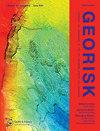基于不同数值方法的智利海岸海啸模拟的系统比较
IF 4.8
3区 工程技术
Q1 ENGINEERING, GEOLOGICAL
Georisk-Assessment and Management of Risk for Engineered Systems and Geohazards
Pub Date : 2022-06-20
DOI:10.3390/geohazards3020018
引用次数: 3
摘要
海啸淹没估计对灾害和风险评估至关重要。在海啸预报中,随着计算能力的提高,数值模拟变得越来越可行。海啸发生后最初几分钟内确定震源的不确定性,可能是在海岸发出适当警报时的一个主要关切。然而,由于结果依赖于合适的模型设置,研究海啸模拟所选择的算法所产生的差异也是至关重要的。在这项研究中,我们使用三种不同的模型(TsunAWI、tsunami - hysea、COMCOT),在改变底部摩擦等参数的情况下,比较了智利中部三个城市(科金博、Viña del Mar和Valparaíso)的海啸淹没情况。TsunAWI在可变分辨率的三角形网格上运行,而其他两个代码则在沿海地区使用嵌套网格。实验以2010 Mw 8.8 Maule、2015 Mw 8.3 Coquimbo和1730 Mw 9.1 Valparaíso三个震源作为实验初始条件。淹没区域是通过基于数值模型具体的湿润和干燥实现的高分辨率地形水深数据集确定的。我们比较了每个模型的结果和灵敏度,以及不同网格几何形状下的底部摩擦和水深表示等参数。结果表明,基于规范内相同震源模型的前波峰近岸波幅估计一致。然而,就淹没而言,我们显示出对曼宁值的高度敏感性,其中非线性行为难以预测。淹没面积的相对减少量与Manning n-range(0.015-0.060)之间的差异很大(11-65%),这与Coquimbo和Valparaíso地区的地形水深特征有很大的关系。由于使用这些模型进行的模拟用于在海啸早期预警背景下产生危害估计和预警产品,因此研究海啸模拟所选择算法所产生的差异至关重要。本文章由计算机程序翻译,如有差异,请以英文原文为准。
Systematic Comparison of Tsunami Simulations on the Chilean Coast Based on Different Numerical Approaches
Tsunami inundation estimates are of crucial importance to hazard and risk assessments. In the context of tsunami forecast, numerical simulations are becoming more feasible with the growth of computational power. Uncertainties regarding source determination within the first minutes after a tsunami generation might be a major concern in the issuing of an appropriate warning on the coast. However, it is also crucial to investigate differences emerging from the chosen algorithms for the tsunami simulations due to a dependency of the outcomes on the suitable model settings. In this study, we compare the tsunami inundation in three cities in central Chile (Coquimbo, Viña del Mar, and Valparaíso) using three different models (TsunAWI, Tsunami-HySEA, COMCOT) while varying the parameters such as bottom friction. TsunAWI operates on triangular meshes with variable resolution, whereas the other two codes use nested grids for the coastal area. As initial conditions of the experiments, three seismic sources (2010 Mw 8.8 Maule, 2015 Mw 8.3 Coquimbo, and 1730 Mw 9.1 Valparaíso) are considered for the experiments. Inundation areas are determined with high-resolution topo-bathymetric datasets based on specific wetting and drying implementations of the numerical models. We compare each model’s results and sensitivities with respect to parameters such as bottom friction and bathymetry representation in the varying mesh geometries. The outcomes show consistent estimates for the nearshore wave amplitude of the leading wave crest based on identical seismic source models within the codes. However, with respect to inundation, we show high sensitivity to Manning values where a non-linear behaviour is difficult to predict. Differences between the relative decrease in inundation areas and the Manning n-range (0.015–0.060) are high (11–65%), with a strong dependency on the characterization of the local topo-bathymery in the Coquimbo and Valparaíso areas. Since simulations carried out with such models are used to generate hazard estimates and warning products in an early tsunami warning context, it is crucial to investigate differences that emerge from the chosen algorithms for the tsunami simulations.
求助全文
通过发布文献求助,成功后即可免费获取论文全文。
去求助
来源期刊
CiteScore
8.70
自引率
10.40%
发文量
31
期刊介绍:
Georisk covers many diversified but interlinked areas of active research and practice, such as geohazards (earthquakes, landslides, avalanches, rockfalls, tsunamis, etc.), safety of engineered systems (dams, buildings, offshore structures, lifelines, etc.), environmental risk, seismic risk, reliability-based design and code calibration, geostatistics, decision analyses, structural reliability, maintenance and life cycle performance, risk and vulnerability, hazard mapping, loss assessment (economic, social, environmental, etc.), GIS databases, remote sensing, and many other related disciplines. The underlying theme is that uncertainties associated with geomaterials (soils, rocks), geologic processes, and possible subsequent treatments, are usually large and complex and these uncertainties play an indispensable role in the risk assessment and management of engineered and natural systems. Significant theoretical and practical challenges remain on quantifying these uncertainties and developing defensible risk management methodologies that are acceptable to decision makers and stakeholders. Many opportunities to leverage on the rapid advancement in Bayesian analysis, machine learning, artificial intelligence, and other data-driven methods also exist, which can greatly enhance our decision-making abilities. The basic goal of this international peer-reviewed journal is to provide a multi-disciplinary scientific forum for cross fertilization of ideas between interested parties working on various aspects of georisk to advance the state-of-the-art and the state-of-the-practice.

 求助内容:
求助内容: 应助结果提醒方式:
应助结果提醒方式:


